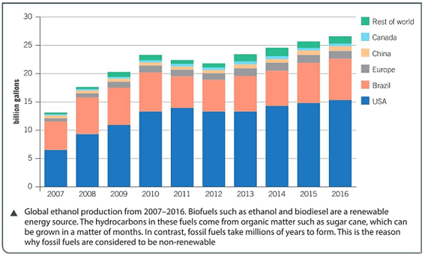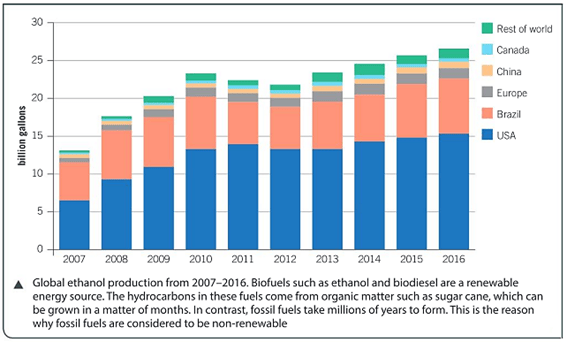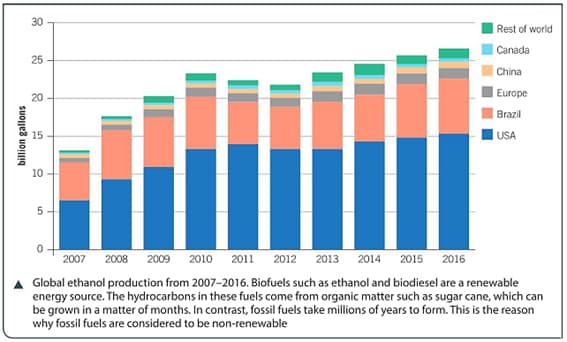Gary Horner Solutions for Chapter: Evidence, Exercise 22: Data-based question: Ethanol and biofuels
Gary Horner Chemistry Solutions for Exercise - Gary Horner Solutions for Chapter: Evidence, Exercise 22: Data-based question: Ethanol and biofuels
Attempt the practice questions on Chapter 2: Evidence, Exercise 22: Data-based question: Ethanol and biofuels with hints and solutions to strengthen your understanding. MYP Chemistry A concept-based approach Years 4&5 solutions are prepared by Experienced Embibe Experts.
Questions from Gary Horner Solutions for Chapter: Evidence, Exercise 22: Data-based question: Ethanol and biofuels with Hints & Solutions
Data-based question: Ethanol and biofuels

Identify the largest producer of ethanol and suggest possible reasons for this.
Data-based question: Ethanol and biofuels

Discuss why the level of production of ethanol has increased from to .
Data-based question: Ethanol and biofuels

China has a large population in global terms and a very large manufacturing sector, but its ethanol production is among the lowest of the nations listed. Why might that be the case? Do you think that this might change in the near future, and if so why.
Data-based question: Ethanol and biofuels

What natural resources might explain Brazil’s high ethanol production?
The text below is part of an online article from the US Department of Energy from October . Note the following details before you read the article.
- is a blend of gasoline and ethanol which contains up to ethanol.
- A US gallon is an imperial unit of measurement of volume. It is the equivalent of litres.
- A US ton is an imperial unit of measurement of mass. It is the equivalent of .
California ramps up biofuels infrastructure
New renewable diesel, biodiesel, and fuelling pumps are cropping up across California as Clean Cities stakeholders work to expand the availability of biofuels.
station. As of , it boasts more than public stations, due in large part to a station-development project known as the Low Carbon Fuel Infrastructure Investment Initiative (LCF). The project has the potential to displace million gallons of petroleum and tons of carbon dioxide emissions per year.
In addition, the project has created more than green jobs in a state particularly hard-hit by unemployment. LCF is funded through an American Recovery and Reinvestment Act award and by the California Energy Commission and Propel Fuels. California has more than million diesel and flexible fuel vehicles on the road, and LCF is now matching the fuels to the vehicles
East Bay Clean Cities and other California coalitions are working with project partners, like Propel Fuels and the California Department of General Service, to target ZIP codes with high densities of alternative fuel vehicles and to find locations where the coalitions’ fleet partners operate. Clean Cities coalitions are also coordinating with station owners to publicize the new facilities, through station opening events, ethanol buy-down days, and identification and outreach to potential fleet customers for the new fuelling facilities.
Biofuels providers and Clean Cities coalitions began laying the foundation for the new fuelling infrastructure back in by contacting elected officials, educating local regulatory agencies, and helping to streamline permitting processes. Today, fuel providers are able to offer station owners turn-key packages, complete with tanks and dispensers, with a minimum of paperwork. And with more stations coming online every month, California is poised to be a global leader in the deployment of low-carbon, alternative fuels.
- Summarise this article for an international audience in not more than words.
The text below is part of an online article from the US Department of Energy from October . Note the following details before you read the article.
- is a blend of gasoline and ethanol which contains up to ethanol.
- A US gallon is an imperial unit of measurement of volume. It is the equivalent of litres.
- A US ton is an imperial unit of measurement of mass. It is the equivalent of .
California ramps up biofuels infrastructure
New renewable diesel, biodiesel, and fuelling pumps are cropping up across California as Clean Cities stakeholders work to expand the availability of biofuels.
station. As of , it boasts more than public stations, due in large part to a station-development project known as the Low Carbon Fuel Infrastructure Investment Initiative (LCF). The project has the potential to displace million gallons of petroleum and tons of carbon dioxide emissions per year.
In addition, the project has created more than green jobs in a state particularly hard-hit by unemployment. LCF is funded through an American Recovery and Reinvestment Act award and by the California Energy Commission and Propel Fuels. California has more than million diesel and flexible fuel vehicles on the road, and LCF is now matching the fuels to the vehicles
East Bay Clean Cities and other California coalitions are working with project partners, like Propel Fuels and the California Department of General Service, to target ZIP codes with high densities of alternative fuel vehicles and to find locations where the coalitions’ fleet partners operate. Clean Cities coalitions are also coordinating with station owners to publicize the new facilities, through station opening events, ethanol buy-down days, and identification and outreach to potential fleet customers for the new fuelling facilities.
Biofuels providers and Clean Cities coalitions began laying the foundation for the new fuelling infrastructure back in by contacting elected officials, educating local regulatory agencies, and helping to streamline permitting processes. Today, fuel providers are able to offer station owners turn-key packages, complete with tanks and dispensers, with a minimum of paperwork. And with more stations coming online every month, California is poised to be a global leader in the deployment of low-carbon, alternative fuels.
- What benefits has LCF brought to California?
Do you think the use of biofuels in your country is important for the future? Explain why or why not?
